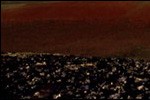
| Home
Mission 2007 Team Members Research Sources Progress Journal |
| Findings of research
on response of arctic tundra plant communities to winter vehicle disturbance Effects of 1984 and 1985 winter seismic exploration on arctic tundra were evaluated at 104 sites on the coastal plain of northeastern Alaska in 1991. All disturbed sites had species whose cover values remained lower than controls, especially nonvascular plants and evergreen shrubs. Graminoids were less affected by disturbance. At high initial levels of disturbance, impacts included i) surface compression at moist sites, with replacement of shrubs and mosses by hydrophytic sedges and ii) persistence of bare patches in drier sites and replacement of prostrate shrubs with grasses. Although recolonizing species were generally common in controls, forbs and graminoids not present in adjacent areas were recolonizing some highly disturbed sites. Active layers were deeper at 55% of sites but shallower at 6 highly disturbed sites, where dead sedge leaves insulated permafrost. Plant biomass and nutrient concentrations were initially higher on disturbed plots, but by 1991 differences only persisted at the most disturbed mesic plot. It is found that impacts to the active layer and plant communities persist eight growing seasons after disturbance. It is observed (Rickard and Brown 1974) that vehicle impacts to tundra ecosystems vary depending upon the degree to which the surface is disrupted. Any kind of surface disturbance or exposure of the organic later decreases albedo and raises soil temperatures, resulting in melting of permafrost. When surface disruption is severe enough, the effects are irreversible. If low impact compression occurs and vegetation is left more or less intact, vehicle passage often produces “greenbelts” by compressing standing dead vegetation. This in turn accelerates decomposition by submerging standing dead vegetation in contact with soil microbes. The flush of nutrients increases productivity in the tracks. Data analysis Data has been collected about changes in plant cover on seismic trail study sites on the coastal plain of ANWR in 1991. Though Team E’s proposal states that seismic exploration tracked vehicles will not be extensively use, the problems of vehicles traveling around ANWR during drilling and surface operation will still affect plant communities in the same way as seismic tracked vehicles because it is the size of and pressure exerted by the vehicles that matter. 0. None. No impact to slight disturbance 1. Low. Less than 25% decrease in vegetation or shrub cover and less than 5% soil exposed 2. Moderate. Vegetation or shurb cover decrease 25-50% and exposed soil 5-15%; compression of mosses and standing litter in wet graminoid and moist sedge; potential change in vegetation composition 3. High. Over 50% decrease in vegetation cover or shrub cover and over 15% and over 15% soil exposed; obvious track depression in wet graminoid and moist sedge – shrub tundra; vegetative mat and ground cover substantially disrupted. Wet graminoid: 0 Moist sedge – shrub: 0,0,0,0,0,0,2,0,3,3 Moist graminoid barren tundra: 1,2,2,3,3,2,2 Moist sedge tussock tundra: 0,0,1,1,2,1,2,2 Moist shrub: 1,1 Riparian shrubland: 1,1,2,1,2 Dryas terrace: 2,1,2 This shows that the moist graminoid barren tundra, or generally speaking, the wetter vegetation, are more seriously impacted. This is because of less resistance of the substrate but often recover faster. In contrast, drier areas is often less damaged by disturbance but take longer to recover because of their dependence on seeds as the source for colonists. The most visible impacts observed in this study were on those sites that have undergone a plant composition change as a result of the change in the physical system (exposed soil and increased thaw depths). At the most severley disturbed moist sedge - shrub sites, compression of the trail and the subsequent nutrient flush caused a species composition change to more hydrophytic sedges and an elimination of willows and mosses. |



| Last updated: Nov 18, 2003 (12am) | Webmistresses: Holly and Lia Team 7 - m2007-7@mit.edu |